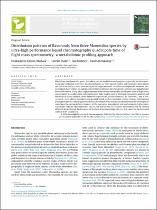 ResearchSpace
ResearchSpace
Distribution patterns of flavonoids from three Momordica species by ultra-high performance liquid chromatography quadrupole time of flight mass spectrometry: a metabolomic profiling approach
JavaScript is disabled for your browser. Some features of this site may not work without it.
- ResearchSpace
- →
- Research Publications/Outputs
- →
- Journal Articles
- →
- View Item
| dc.contributor.author |
Madala, NE

|
|
| dc.contributor.author |
Piater, L

|
|
| dc.contributor.author |
Dubery, I

|
|
| dc.contributor.author |
Steenkamp, Paul A

|
|
| dc.date.accessioned | 2017-07-28T08:53:27Z | |
| dc.date.available | 2017-07-28T08:53:27Z | |
| dc.date.issued | 2016-08 | |
| dc.identifier.citation | Madala, N.E., Piater, L., Dubery, I. et al. 2016. Distribution patterns of flavonoids from three Momordica species by ultra-high performance liquid chromatography quadrupole time of flight mass spectrometry: a metabolomic profiling approach. Brazilian Journal of Pharmacognosy, vol. 26: 507-513. http://dx.doi.org/10.1016/j.bjp.2016.03.009 | en_US |
| dc.identifier.issn | 0102-695X | |
| dc.identifier.uri | http://www.sciencedirect.com/science/article/pii/S0102695X16300461?via%3Dihub | |
| dc.identifier.uri | http://dx.doi.org/10.1016/j.bjp.2016.03.009 | |
| dc.identifier.uri | http://hdl.handle.net/10204/9281 | |
| dc.description | Copyright: 2016 Sociedade Brasileira de Farmacognosia. This is an Open Access article. | en_US |
| dc.description.abstract | Plants from the Momordica genus, Curcubitaceae, are used for several purposes, especially for their nutritional and medicinal properties. Commonly known as bitter gourds, melon and cucumber, these plants are characterized by a bitter taste owing to the large content of cucurbitacin compounds. However, several reports have shown an undisputed correlation between the therapeutic activities and polyphenolic flavonoid content. Using ultra-high performance liquid chromatography quadrupole time of flight mass spectrometry in combination with multivariate data models such as principal component analysis and hierarchical cluster analysis, three Momordica species (M. foetida Schumach., M. charantia L. and M. balsamina L.) were chemo-taxonomically grouped based on their flavonoid content. Using a conventional mass spectrometric-based approach, thirteen flavonoids were tentatively identified and the three species were found to contain different isomers of the quercetin-, kaempferol- and isorhamnetin-O-glycosides. Our results indicate that Momordica species are overall very rich sources of flavonoids but do contain different forms thereof. Furthermore, to the best of our knowledge, this is a first report on the flavonoid content of M. balsamina L. | en_US |
| dc.language.iso | en | en_US |
| dc.publisher | Elsevier Editora Ltda | en_US |
| dc.relation.ispartofseries | Worklist;18039 | |
| dc.subject | Momordica | en_US |
| dc.subject | UHPLC-qTOF-MS | en_US |
| dc.subject | Flavonoids | en_US |
| dc.subject | Principal component analysis | en_US |
| dc.subject | Chemotaxonomy | en_US |
| dc.subject | Hierarchical cluster analysis | en_US |
| dc.title | Distribution patterns of flavonoids from three Momordica species by ultra-high performance liquid chromatography quadrupole time of flight mass spectrometry: a metabolomic profiling approach | en_US |
| dc.type | Article | en_US |
| dc.identifier.apacitation | Madala, N., Piater, L., Dubery, I., & Steenkamp, P. A. (2016). Distribution patterns of flavonoids from three Momordica species by ultra-high performance liquid chromatography quadrupole time of flight mass spectrometry: a metabolomic profiling approach. http://hdl.handle.net/10204/9281 | en_ZA |
| dc.identifier.chicagocitation | Madala, NE, L Piater, I Dubery, and Paul A Steenkamp "Distribution patterns of flavonoids from three Momordica species by ultra-high performance liquid chromatography quadrupole time of flight mass spectrometry: a metabolomic profiling approach." (2016) http://hdl.handle.net/10204/9281 | en_ZA |
| dc.identifier.vancouvercitation | Madala N, Piater L, Dubery I, Steenkamp PA. Distribution patterns of flavonoids from three Momordica species by ultra-high performance liquid chromatography quadrupole time of flight mass spectrometry: a metabolomic profiling approach. 2016; http://hdl.handle.net/10204/9281. | en_ZA |
| dc.identifier.ris | TY - Article AU - Madala, NE AU - Piater, L AU - Dubery, I AU - Steenkamp, Paul A AB - Plants from the Momordica genus, Curcubitaceae, are used for several purposes, especially for their nutritional and medicinal properties. Commonly known as bitter gourds, melon and cucumber, these plants are characterized by a bitter taste owing to the large content of cucurbitacin compounds. However, several reports have shown an undisputed correlation between the therapeutic activities and polyphenolic flavonoid content. Using ultra-high performance liquid chromatography quadrupole time of flight mass spectrometry in combination with multivariate data models such as principal component analysis and hierarchical cluster analysis, three Momordica species (M. foetida Schumach., M. charantia L. and M. balsamina L.) were chemo-taxonomically grouped based on their flavonoid content. Using a conventional mass spectrometric-based approach, thirteen flavonoids were tentatively identified and the three species were found to contain different isomers of the quercetin-, kaempferol- and isorhamnetin-O-glycosides. Our results indicate that Momordica species are overall very rich sources of flavonoids but do contain different forms thereof. Furthermore, to the best of our knowledge, this is a first report on the flavonoid content of M. balsamina L. DA - 2016-08 DB - ResearchSpace DO - 10.1016/j.bjp.2016.03.009 DP - CSIR KW - Momordica KW - UHPLC-qTOF-MS KW - Flavonoids KW - Principal component analysis KW - Chemotaxonomy KW - Hierarchical cluster analysis LK - https://researchspace.csir.co.za PY - 2016 SM - 0102-695X T1 - Distribution patterns of flavonoids from three Momordica species by ultra-high performance liquid chromatography quadrupole time of flight mass spectrometry: a metabolomic profiling approach TI - Distribution patterns of flavonoids from three Momordica species by ultra-high performance liquid chromatography quadrupole time of flight mass spectrometry: a metabolomic profiling approach UR - http://hdl.handle.net/10204/9281 ER - | en_ZA |





